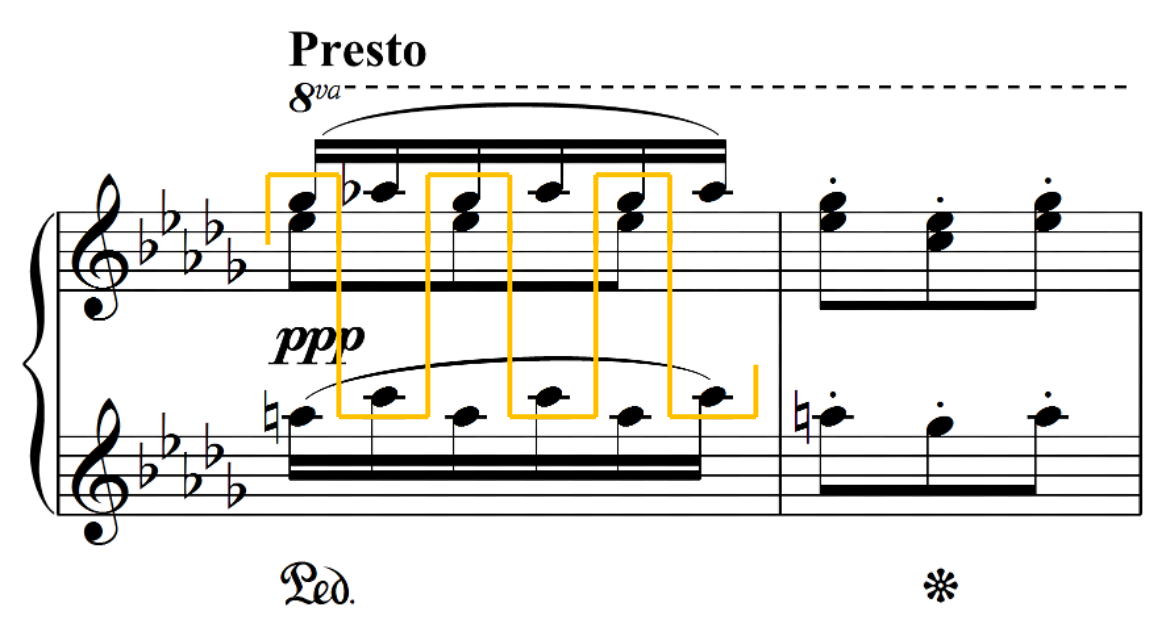Fingerings in Italics are Liszt’s.
“The first note of these triplets can always be taken with the right hand to avoid stretching or rolling.”
Submitted by Michael Clark
Published on 1/1/2020
Fingerings in Italics are Liszt’s.

“The first note of these triplets can always be taken with the right hand to avoid stretching or rolling.”
Submitted by Michael Clark
Published on 1/1/2020

“As this pattern descends, it can be divided by the hands to maximize power and visual excitement.”
Submitted by Michael Clark with thanks to Nancy Weems
Published on 1/1/2020

“This redistribution makes the RH difficult to keep even and keep the musical sound distinct for the redistributed notes. But the resulting accuracy of the LH outweighs that difficulty in my opinion. The pattern may be continued into the next measure, but I found the leap is not as difficult.”
Submitted by Mary Katherine Schober
Published on 3/29/2020

“The left hand is free to help with the repeated notes.”
Submitted by Michael Clark
Published on 3/18/2020

“Josef Raieff suggested performing these two measures with the Viennese-style “compression” on Beats 1 and 2. Taking the final notes with the LH is not only a fun bit of choreography, but prevents the student from giving an undesirable accent of beat 3.”
Submitted by Sam Welsh with thanks to Josef Raieff
Published on 3/26/2020


“Some students may have an easier time distributing these tremolo figures between the hands. At a presto tempo, any lack of coordination between the hands (as written) results in a ragged, jangly version. Alternating between the hands keeps the articulation crisp.”
Submitted by Sam Welsh
Published on 3/26/2020

“Dividing these sixths between the hand improves legato and helps control the dynamic level of the accompaniment.”
Submitted by Michael Clark
Published on 1/1/2020

“Taking these tenor notes in the right hand allows the bass note to be held for clearer pedaling.”
Submitted by Michael Clark
Published on 8/11/2021

“Taking these tenor notes in the right hand allows the bass note to be held for clearer pedaling.”
Submitted by Michael Clark
Published on 8/11/2021

“I can reach the B-flat on the downbeat of m. 44 with my right-hand thumb which eliminates the need to jump in the left hand and facilitates clearer pedaling. When the left hand has rests, it can play the melody notes, freeing the right hand for better control of the sixteenth notes.”
Submitted by Michael Clark
Published on 1/1/2020

“Taking the B-flat in the left hand continues the technical pattern of the previous measure and allows the right hand to begin in a more compact position.”
Submitted by Michael Clark
Published on 8/11/2021

“I find easier to jump to this distribution of the chord.”
Submitted by Michael Clark
Published on 8/11/2021
Fingerings in Italics are Liszt’s.

“These notes are easily within the right hand’s reach.”
Submitted by Michael Clark
Published on 1/1/2020
Fingerings in Italics are Liszt’s.

“Finding a suitable fingering for playing the C-double-sharp in the right hand is difficult. Taking it in the left hand solves the problem.”
Submitted by Michael Clark
Published on 1/1/2020
Fingerings in Italics are Liszt’s.

“Playing the D in the left hand requires a wide leap that can be avoided by taking the D in the right hand.”
Submitted by Michael Clark
Published on 1/1/2020

“Taking the D-sharp in the right hand prevents the left hand having to cross over for one note, which I prefer to avoid when possible.”
Submitted by Michael Clark
Published on 1/1/2020

“Taking the top notes of these large rolls in the right hand allows for the bass note to be held for a clearer pedal change.”
Submitted by Michael Clark
Published on 1/1/2020

“Taking the top notes of these large rolls in the right hand allows for the bass note to be held for a clearer pedal change.”
Submitted by Michael Clark
Published on 8/11/2021